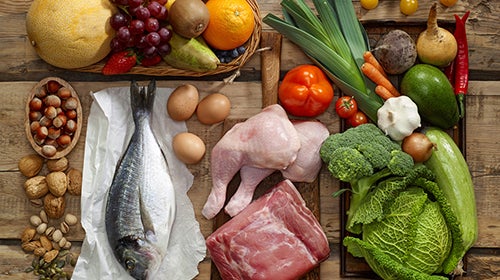A lot of us have probably heard about the crazy lengths that people will go through to lose weight. Dieting is one of the common ways to do this but even so, there are a lot of different diets that people can actually choose from.
Let’s take a look at some fad diets and see what really happens if you go through with them…
1. The Pioppi Diet
This diet was created out of research done by Dr. Aseem Maholtra and Donal O’Neill in a tiny fishing village called Pioppi in the south of Italy.

Source: Cilento Travel
Some of the core principles of the 21-day diet include:
- No added sugars for the first 2 weeks – cutting out all bread, pasta and rice.
- 2 -4 tablespoons of extra virgin olive oil per day as well as a handful of nuts.
- Butter, cheese and full-fat yoghurt is not restricted.
- Walking for a minimum of 30 minutes a day.
- One 24-hour fasting period each week.
What you need to know
There’s a few things that can be considered controversial with this diet and some of it can backfire on your weight loss really badly.
- Blocking out carbohydrates completely. There’s a good chance that you could end up overeating instead as your body needs carbohydrates.
- Fasting for one 24-hour period each week – an issue if done for long periods of time as the initial weight lost on a fast is primarily fluid or “water weight,” not fat.
- What is researched is not consistent with what the diet follows, hence it raises a lot of other questions.
2. The Paleo Diet
Taking it’s cue from the diet of our ancestors, those who follow this diet try their best to eat as naturally as possible. Processed foods are a big no-no! There are different variations of the diet where low-fat dairy products are allowed but some will even frown at fruits or vegetables that may contain too much fructose.

Source: Coach
Here are the important points for those on this diet:
- Opting for grass-fed meats.
- An abundance of fruits and vegetables.
- Consuming wholefoods like nuts and seeds.
- Eating more healthy fats.
- Avoid legumes, starches, processed sugar among other things.
What you need to know
Some common side effects from the Paleo diet are:
- Lack of energy – this happens from cutting out the carbs in your diet. There’s even a term for the adjustment period that you go through called “low-carb flu”.
- Increases your chances of diarrhoea, as it radically alters the bacteria in your gut.
- Taking in excess protein which is not something your body needs.
3. The Blood Type Diet
Nope, it’s not a diet where you become a vampire and only take blood because…

Started by Peter J. D’Adamo, this particular diet looks at your actual blood type and then your blood type dictates what you can and cannot take. The reasoning behind this diet is that each blood group has its own unique antigen markers and these markers reacts badly with certain foods, leading to all sorts of potential health problems.
Here’s a list of the different blood types and what you should or shouldn’t be eating:
| Blood Type | Yes | No |
|---|---|---|
| A | – Plants | – Red meat |
| B | – Plants – Other meats – Some dairy |
– Pork – Chicken – Wheat – Corn – Lentils – Tomatoes – Others |
| AB | – Seafood – Tofu – Dairy – Beans – Grains |
– Kidney beans – Corn – Beef – Chicken |
| O | – Meat – Fish – Poultry – Certain fruits – Certain veges |
– Grains – Legumes – Dairy |
What you need to know
- Major medical centers and teaching hospitals like the NYU Langone Medical Center do not recommend following the blood type diet. This is due to a lack of solid scientific evidence and because there’s a severe diet restriction on what you can eat.
- D’Adamo’s research is marked with lots of inconsistencies. Eg. He claims that blood type O is the “original” blood type. However, other evidence shows that A was the first blood type to exist, and many agree that more studies are needed to grasp the evolution.
- The possibility of nutritional deficiencies with certain blood types.
4. The Alkaline Diet
As the name indicates, this particular diet looks towards “science”. The belief is that eating specific foods that make your body more alkaline can protect you against other foods, which can cause your body to produce more acid and in turn this can also help you lose weight.

Source: YouTube
Of course, all this involves first finding out what your pH levels are, which leads to either a urine test or using your saliva and pH strips.
To follow the diet, there are different food groups that fall under different pH categories and they are as follows:
- Acidic: Meat, poultry, fish, dairy, eggs, grains and alcohol.
- Neutral: Natural fats, starches and sugars.
- Alkaline: Fruits, nuts, legumes and vegetables.
The ultimate goal is to consume 80% alkaline foods and 20% acidic foods.
What you should know
Some of the things associated with the alkaline diet are:
- Problems caused by consuming large quantities of alkaline water and increasing the pH of the stomach such as longer food digestion.
- The potential of missing out on certain good things like healthy doses of omega 3s in fish and other healthy fats it suggests scaling back on.
- Urine pH is not a reflection of blood PH. It’s impossible to change the PH of the blood.
5. The Ketogenic (Keto) Diet
Can’t cover fad diets without including the diet that everyone’s aunt is probably trying out now! The Ketogenic or Keto diet has actually been around for awhile but it has been gaining in popularity recently thanks to endorsements from Kourtney Kardashian and other celebs.

Here’s the basic guide to Keto:
- Consists of eating 80 percent fat and little to no carbohydrates.
- Keto diet staples are fish, meat, eggs, dairy, oils, and green vegetables.
- Pasta, rice and other grains, potatoes, and fruits are strictly not allowed.
How it works is that on this particular diet, your entire body switches its fuel supply to run almost entirely on fat. It relies on an alternative fuel for the body called “ketones”, so that this can happen.
What you should know
- It can affect your hydration levels. Specifically, your electrolytes could become imbalanced due to the limited intake of carbohydrates.
- High-fat foods that are low in protein and carbohydrates, like coconut and egg yolks, are high in saturated fat, which can increase your risk of heart disease.
- Consuming more protein than you need can lead to increased levels of uric acid in the blood.
Conclusion
At the end of the day, it all comes down to what you’re willing to put your body through. Different people respond differently to different diets. What’s best though is to look at a well-balanced diet and an active lifestyle, as they will definitely benefit you in the long run. You don’t want to gain back all that weight once you slack off from your diet, right? As these diets have shown, sustainability is what’s crucial.
Also read: 7 ‘Healthy’ Habits Malaysians Have That Can Actually Lead to Diabetes



































